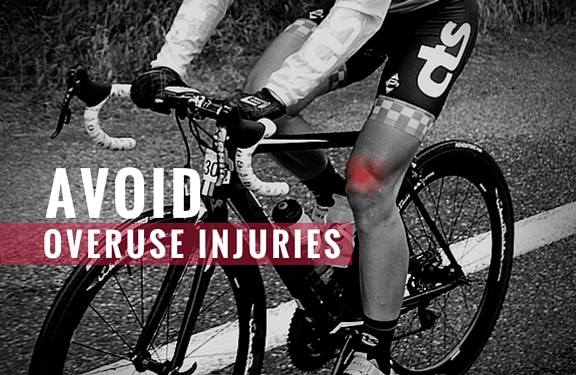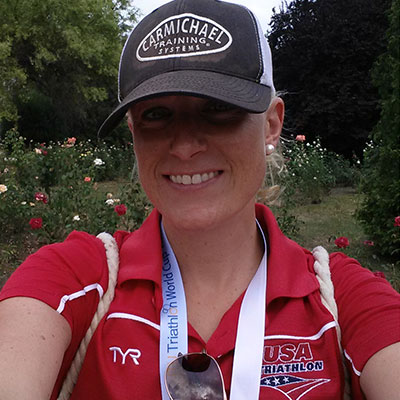
How to Avoid Overuse Injuries in 5 Easy Steps
You’ve just registered for an event and you’re two weeks into a serious training program. You’re excited about your workouts and feeling like a superhero. Then one day your knee’s a little sore after a ride. You push through it for the next few days and now it’s hurting when you walk as well as when you ride. Finally, someone notices you wince as you go down the stairs. “I’m fine,” you say, but in reality, you’re suffering from an overuse injury.
The essence of training is based on the concept that the tendons, ligaments, and muscles adapt to training stress over a period of time. And as you adapt to training, you need to progressively increase the training load in order to continue making progress. That increase in workload, however, can be a double-edged sword because increasing volume and/or intensity too rapidly can lead to overuse injuries. The early season is often when overuse injuries occur because it’s when athletes ramp up their training for events later in the spring and summer.
[blog_promo promo_categories=”coaching” ids=”” /]What Causes Overuse Injuries?
Overuse injuries are often caused by mechanical fatigue when tendons, ligaments, muscles and other soft tissues become excessively fatigued without adequate recovery.
Frequently, endurance athletes experience overuse injuries such as IT-Band syndrome, and patella, or Achilles tendonitis due to abruptly increasing training volume or intensity with poor biomechanics and insufficient rest.
And it’s usually not one training session that brings on an overuse injury; they typically result from repetitive trauma to tendons, bones and joints.
How to Avoid Overuse Injuries
1. Only Increase Training Load by a Maximum of 8-10% per Week
A general rule of thumb in endurance sport is to not increase training load more than 10% week over week; I tend to be conservative and recommend 8% to be on the safe side. For example, if you are riding a total of 6-hours this week a 10% increase would equal about 30 minutes, which means the following week training should be capped around 6.5-hours.
Feel Stronger in 6 Weeks — No Matter Your Age
Climbs feel steeper? Recovery slower?
You’re not done getting faster — you just need a smarter plan.
The 6-Week Masters Power Build Coaching Program is designed for cyclists 50+ who want to boost power, recover faster, and ride stronger — all with expert 1:1 coaching.
- Personalized 6-Week Training Plan
- 1:1 Coaching + TrainingPeaks Premium
- Mobility & Strength Bonus Guides
💪 Guarantee: Stronger or free.
Start your 6-week journey for $149By logging your training in TrainingPeaks, you can also track your training progression through Performance Manager Chart. A safe, slightly conservative approach would be to consistently increase your CTL (Chronic Training Load) by 5-8 TSS per week. The CTL takes into consideration both volume and intensity of your training to measure the increased chronic stress of training over a period of time.
[blog_promo promo_categories=”camp” ids=”” /]2. Pay Attention to Mechanics
Improper technique is also a major factor in tendonitis types of injuries, especially in endurance sports that feature highly repetitive motions. If a cyclist has a poor bike fit and they ride for 1-hour at 85-rpm, they are pedaling 5,100 revolutions with a cycling position that’s potentially aggravating tendons in the ankle, knee, or hip! If you’re attentive and address the problem quickly, you can often prevent it from becoming a chronic injury.
3. Include Sufficient Rest When Designing Your Training Plan
Your body is amazing at adapting to training stress, and even adapting to changes in your biomechanics. But adaptation takes time and recovery. Ideally, athletes should include at least 1 day of complete rest for every 7 to 10 days of training.
4. Identify Good Pain Versus Bad Pain
Good pain is a result of overload from a training program that features progression. If you’re adapting well to the training, soreness or pain will be absent the next day and you’ll have the energy for a high-quality workout. Pain that remains present and relatively constant throughout a workout, (even if it lessens a bit after a good warmup) is an indication that you’re pushing beyond your body’s ability to recover.
5. Properly Warm Up Before Training, Especially High-Intensity Training
A proper warm-up may last 10-20 minutes depending on the length and intensity of your training session. A more intense training session may require a slightly long warm-up period. The jury is still out on whether stretching – dynamic or static – reduces the likelihood of tendonitis, but you can’t go wrong by increasing blood flow to working muscles through a warmup routine.
[blog_promo promo_categories=”bucket list” ids=”” /]What to Do if You Get an Overuse Injury
If you’re an endurance athlete with training or competition goals that are important to you, visit a physical therapist if you’re experiencing symptoms of an overuse injury. There may be treatments and specific exercises you can do to accelerate your recovery.
► Free Cycling Training Assessment Quiz
Take our free 2-minute quiz to discover how effective your training is and get recommendations for how you can improve.
And when you’re ready to get back to training work with a certified coach or biomechanics expert to assess your cycling position, running form and/or swimming technique to ensure you are incorporating appropriate technique.
A very important step upon returning to active training is to make sure you are reconditioning your body to operate with proper biomechanics. This may mean taking a step back in the intensity of your training so you can focus on technique for a while, and then begin increasing training load by a conservative 5-8% per week for the first 2-3 weeks back to training.
Related Articles
Triathlon Training: Running Injuries Near the End of Ironman Training
How to Perform at Your Best in Every Decade
Lindsay Hyman

Lindsay Hyman has a Masters of Science in Exercise Physiology, is a Pro Level coach with Carmichael Training Systems, and is a USA Triathlon Level 2 certified coach. She has been coaching for 11 years and works with athletes looking to complete their first Ironman race to athletes who have won at the World Championships in Kona. Lindsay’s passion for triathlon began at the age of 7 at the local Ironkids race in Colorado and she still competes in ultra-endurance events today. Her coaching philosophy is to provide indispensable tools, education, and experience to develop an athlete’s potential within sport and in life. Most important, she creates a training program specific to each athlete’s needs and goals, emphasizing a healthy and well-balanced life, and strives to establish a positive training environment for the pursuit of athletic achievement. For information on personal coaching, training camps, and Endurance Bucket List events, visit https://trainright.com.
► FREE Mini-Course: Learn How to Maximize Your Limited Training Time
Learn step-by-step how to overcome limited training time and get faster. Walk away with a personalized plan to increase your performance.
"*" indicates required fields


Comments 7
Muiuto obrigado, este artigo é apropriado, eu mesmo ja fiz coisas erradas deste tipo que me resultou um ano longe da bike, agora eu tenho cuidado.
Pingback: When Less Training Is Not an Option
Its also important to look at the length of each ride, vs a weekly total…For instance, riding 100 miles /week with 3 rides of 33 miles each, is very different from a 40-mile and a 60-mile ride, altho the “totals” look the same.
These are all beneficial methods that you have mentioned. Surprised you left off some others…..massage, foam rolling, trigger point, therapies. Hydration/Nutrition guidelines, and strength training to address weaknesses/imbalances are just a few that quickly come to mind and contribute to avoidance of overuse injuries.
Thank you for the reminder to continue to keep my mind listening to the rest of my body.
” . . . increase your CTL (Chronic Training Load) by 5-8 TSS per week.” You define CTL here, but what, pray tell, does TSS refer to?
Training Stress Score – but you have to be really into Training Peaks and training with power to use it properly and effectively. I think its a very good indicator / part of the tool box and I use it religiously. Wouldn’t be without it now.